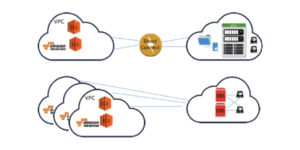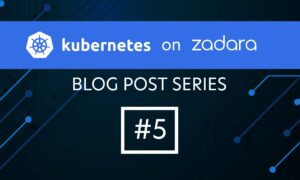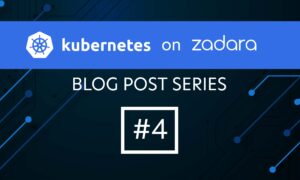A recurring question our new customers ask is: “are you providing a storage solution on top of Amazon Elastic Block Storage (AWS EBS)?” While there are those vendors who employ this approach, Zadara delivers an enterprise solution by allocating individual physical drives to each customer that are completely isolated from those of other customers and from the EBS infrastructure.
Zadara Storage Clouds are built in data centers adjacent to Amazon EC2 and connected to EC2 using multiple short, private, redundant 10Gbps links in each region (this capability is called AWS Direct Connect). As shown in the figure below, your AWS Virtual Private Cloud is directly connected to Zadara and will be seen as native block and file storage to your AWS EC2 instances.
So when should you use EBS and when should you deploy VPSA? In order to compare the two storage services at Amazon, let me begin by defining each service:
What is EBS?
Elastic Block Storage is an Amazon Web Services cloud storage service that provides a block device mapped directly into one (and only one) EC2 instance. A variant of EBS is called Provisioned IOPS (PIOPS) and provides a provisioned Quality-of-Service (QoS) block device, again mapped to a single EC2 instance. The drives are not attached locally to the same server your virtual EC2 instance is hosted on, but available within the same availability zone (AZ) as a simple block device. These LUNs are virtual and sit on top of physical drives which are shared by many customers.
You can specify the QoS, volume size and media type such as SSD or HDD. QoS has specifications such as:
- Provisioned IOPS (PIOPS) are 16k
- Minimum of 30:1 IOPS to GB ratio
- Maximum of 20,000 IOPS per LUN
- Maximum of 16 TB SSD and 1TB HDD
- Maximum 320 MB/s
For general purpose EBS SSD’s, maximum IOPS and throughput are half that of provisioned SSD’s, or 10,000 and 160 MB/s, respectively.
What is a Zadara VPSA™ Storage Array?
Zadara VPSA is an enterprise-grade cloud storage solution that provides fully featured, high performance, high availability, low-latency unified file and block storage.
Just like EBS, Zadara storage is hosted on separate infrastructure available via high speed interconnects. However, Zadara volumes are mapped into E2C instances using block volumes and also as NFS or SMB/CIFS protocols as well. In addition, Zadara’s block volumes can be exposed to multiple servers for clustering or shared file systems.
These LUNs are virtual, but unlike EBS, they sit on top of physical drives used only by you. As the Zadara Storage Cloud is situated independently of EBS, it enables you to receive dedicated storage not shared with any other users, yielding high, predictable performance and better security and privacy features (exceeding AWS’ already impressive security and privacy).
VPSA features large volumes (+100TB), volume sharing across multiple instances, NFS and SMB/CIFS protocols for native file access, data-at-rest and data-in-flight encryption with customer-managed keys and a full set of enterprise data management features (snapshots, cloning, thin provisioning, SSD caching, remote replication, and more).
How Do They Compare?
Whenever you evaluate a storage solution—even Zadara’s—make sure that the solution meets your requirements and includes the time it takes to manage and provision the storage.
This table gives you a quick comparison between EBS (as of Jan 2016) and Zadara’s VPSA.
| Requirement | AWS EBS | Zadara VPSA at AWS |
| Maximum SSD IOPs | 20k | 35k PIOPS, 100k+ for 4K I/Os |
| Maximum SSD Volume | 16 TB | 32 TB |
| Maximum SSD Throughput | 320 MB/s | 600 MB/s |
| Maximum HDD IOPs | 40 – 200 | 200 – 4000 |
| Peak HDD IOPs | Hundreds | +20k |
| Maximum HDD Volume | 1 TB | +100 TB |
| Maximum HDD Throughput | 90 MB/s | 600 MB/s |
| Block Support | Yes | Yes |
| CIFS Support | No | Yes |
| NFS Support | No | Yes |
| High Availability | No | Yes |
| Snapshots | Yes | Yes |
| Backup | 3rd Party | Yes, incremental |
When should I use EBS and when VPSA?
Of course, if EBS meets your requirements and you have the resources to manage and maintain the storage, EBS is a great solution. But for most enterprise applications and deployments having higher performance, big volumes, high availability and integrated backup features, the VPSA will help to gain better results quicker, and will also alleviate the need (and time) to manage a complex storage stack and ultimately more cost efficient. In fact, you can cut your storage costs in half, by using VPSA.
Please take advantage of our 7-day trial. We provide and handle the Direct Connects to your AWS environment, where you can benefit from enterprise storage fully managed for you. Unlike EBS, you don’t need an IT staff to develop and maintain an HA solution since we provides this as a service included with your VPSA. If you have any questions, the Zadara Ops team and I are available to help you find the most fitting and cost-efficient deployment for your workloads in the AWS cloud.





